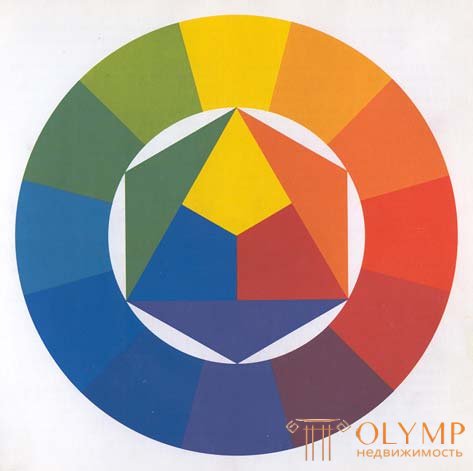
To introduce the color design system, we will create a twelve-color color circle based on the primary colors — yellow, red, and blue (Fig. 3).

As is well known, a person with normal vision can determine the red color, which has neither a bluish nor a yellowish tint; yellow - not having a greenish or reddish, and blue, not having a greenish or reddish hue. At the same time, studying each color should be considered on a neutral gray background.
Primary colors should be determined with the greatest possible accuracy.
The three primary colors of the first order are placed in an equilateral triangle so that yellow is at the top, red is at the bottom right and blue is at the bottom left. Then this triangle fits into a circle and an equilateral hexagon is built on its basis. In the resulting isosceles triangles, we place three mixed colors, each of which consists of two primary colors, and thus we obtain second-order colors:
All colors of the second order must be mixed very carefully. They should not lean toward any of their components. Remember that it is not an easy task to obtain composite colors by mixing them. Orange should not be too red or too yellow, and purple should not be too red or too blue.
Then, at some distance from the first circle, we draw another and divide the ring between them into twelve equal parts, placing the primary and composite colors according to their location and leaving an empty sector between every two colors.
We enter colors of the third order into these empty sectors, each of which is created by mixing colors of the first and second order, and we get:
Thus, there is a correct color circle of twelve colors, in which each color has its unchanged place, and their sequence has the same order as in a rainbow or in a natural spectrum (Fig. 3).
In his time, Isaac Newton received this vicious circle of colors, in which he added the missing magenta color to the spectral colors, which strengthened his overall constructiveness.
In our circle, all twelve colors are equal segments, so the colors, which occupy diametrically opposite places with respect to each other, are additional.
This system allows you to instantly and accurately imagine all twelve colors and easily arrange between them all their variations.
It seems to me that for artists it would be a waste of time to do a color circle of 24 or 100 colors. And what kind of artist can clearly imagine, for example, the 83rd gradation of a color wheel divided into 100 parts without any help?
Since our ideas about color are not very precise, it is useless to discuss this issue. And you just need to see twelve colors with the same certainty with which a musician hears twelve tones of his scale.
Delacroix attached a color wheel to one of the walls of his workshop, on which all the combinations possible with given color were given near each color. The Impressionists, Cezanne, Van Gogh, Signac, Seurat, and other artists valued Delacroix as an outstanding colorist. And it is Delacroix, and not Cezanne, who is considered the founder of the design of works based on logically objective color laws, thereby allowing to achieve a higher degree of order and truth.
Что бы оставить комментарий войдите
Комментарии (0)